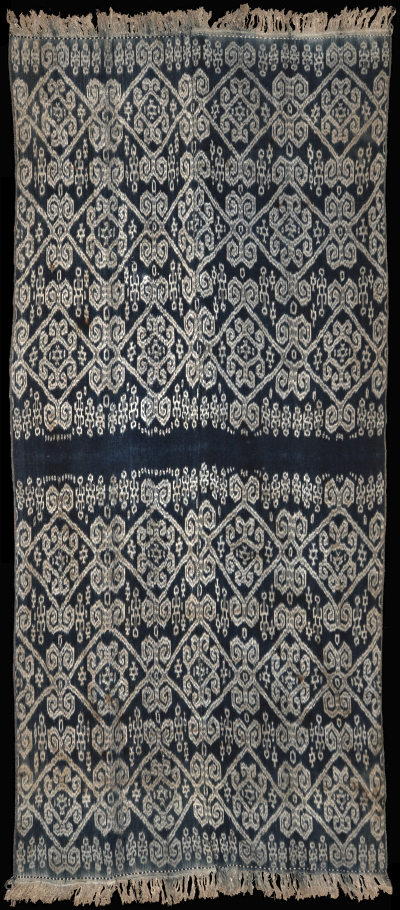| |
 
 | | | |
112 Timor, West Timor
Mau naek (men's wrap)  
| | Locale: | Amanuban, largest of the old Atoni kingdoms. | | Period: | Circa 1910 | | Yarn: | Cotton, hand-spun, medium | | Technique: | Warp ikat | | Panels: | 2 | | Size: | 90 x 195 cm (2' 11" x 6' 4") LW: 2.17 | | Weight: | 695 g (24.5 oz), 396 g/m2 (1.30 oz/ft2) | | Design: | Design called kai nanan. Six rows of nested rhomb and hooks motifs motifs, alternating between four in a row and three plus two halves. Numerous small zoomorphic motifs, almost certainly representing crocodiles, serve as fillers in the spaces between the rows. The rhomb and hooks motifs, tanduk, are similar to kaif motifs - representing links to the ancestors - reduced to their most basic shape, with only eight external hooks, and no internal hooks. This design type, with ikated motifs covering the entire field and no borders, is most commonly seen in the Niki-Niki region. | | Comment: | Archetypical Amanuban mau in good condition for its age. The weaver, as was often done in the early 20th c. Ambenu, was not content to simply leave the reserved motifs white, but spickled them with short indigo bars so that they appear pale blue - a stylistic choice that required a vast amount of extra work: well over 2500 additional bindings. Slight local fading on one side only, various light smudges, but no holes or tears, and colour still deeply saturated. Ex collection Rita and René Wassing-Visser. | | Background: | Chapters on Timor and West Timor. | | Exhibited: | Timor: Totems and Tokens, Museu do Oriente, Lisbon, 2019/20. | | Published: | Ikat Textiles of the Indonesian Archipelago, 2018 | | Compare: | 181 182 005 245 312 | | Sources: | Though the pattern is instantly recognizable as Amanuban, and for that reason here called archetypical, few close cognates were found in literature. The closest is a mau being woven in Amanuban Timur, shown on a photo in Yeager and Jacobson, Textiles of Western Timor, Fig. 94. A rather similar example, also from Amanuban Timur, is shown in the same work on Plate 79. Another fairly similar early 20th c. piece in the Tropenmuseum collection, TM 2301-20, has a field divided into wider and narrower bands rather than a unified field. Bü and Fischer in `The Patola of Gujarat see patola-influence in this type, see the Amanuban on Fig. 228. Design identified by Timorese James Kase. | | |

©Peter ten Hoopen, 2025
All rights reserved.
|
|


